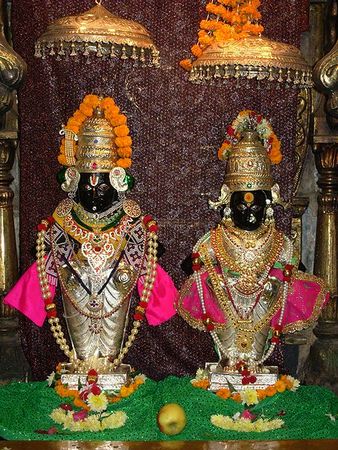 | « Back to article | Print this article |
Ashadhi Ekadashi: What you must know
Today is one of the holiest days in the Hindu calendar. Here's what you should know about it.
On the 11th day of the Hindu lunar month of Ashadh one gets to see thousands of devotees -- often from the Warkari community -- marching on foot towards the holy town of Pandharpur in Maharashtra's Solapur district to worship the state's reigning deity Lord Vitthal or Vithoba as he is fondly called.
Believed to be a manifestation of Vishnu or his incarnation, Krishna, Vitthal and is often depicted as standing on a brick, occasionally accompanied by his consort Rakhumai.
Often known as the people's god -- in his hymns, devotees often refer to him as a friend -- Vitthal has several legends surrounding him. The most popular is that of Pundalik, an ardent devotee who he decided to pay a visit. Unmindful of the divine visitor at his doorstep, Pundalik who was attending to his parents inside, threw a brick in his direction for the visitor to stand on. Obediently, Vitthal stood outside the door waiting for Pundalik to see him. The image of him on the brick with his arms-akimbo you see today is believed to have its roots to this story.
Ashadhi Ekadashi: What you must know
While Hindus regard two eleventh days of every month -- post the New Moon (Amavasya) and Full Moon (Poornima) day -- as very auspicious, the eleventh day of the month of Ashadh has a special significance.
It is on this day, also called as Mahaekadashi or Shayani Ekadashi that Lord Vishnu -- whose avatar Lord Vithoba is -- according to a legend, went to sleep and woke up four months later. In a way, Ashadhi Ekadashi marks the onset of four holy months (Chaturmas) that culminates with the end of monsoons.
While devotees are not obligated to fast on the day of Ashadhi Ekadashi many Warkaris fast on this day and end the fast after Lord Vithoba's darshan at Pandharpur.
Interestingly, these Warkaris -- followers of Lord Vithoba who was popularised as the 'deity of the poor' by the Bhakti Movement in Maharashtra led by great saints like Tukaram, Janabai, Namdev, Dnyaneshwar and many more -- set out on foot a good 21 days before the Ashadhi Ekadashi.
Along the way they dance and sing paens -- mostly abhangs by these great saints devotd to Lord Vithoba -- to spread the essence of the Bhakti Bhav espoused by the saints.
Their Wari -- or religious pilgrimage on foot -- ends at Pandharpur on the day of Ashadhi Ekadashi and once they see the black coloured idols of Vithoba and his cohort Rukmani inside the temple complex they set back to their villages and towns.
While there is no exact confirmation as to when the tradition of Warkaris setting out on foot to Pandharpur begun, many in Maharashtra believe that this is a 700 to 800 year old tradition.
Another interesting tradition that these Warkaris follow is that after the darshan of their beloved deities cutting across caste, creed and gender they touch the feet of any and every person they come across.
The belief is every devotee that throngs to the Vithoba temple on this auspicious day is blessed by the Lord and takes the form of the Lord.

